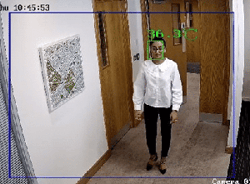We are all afraid of contracting coronavirus. We are all afraid of passing on coronavirus to our family, friends and colleagues. As employers we want to protect our most valuable asset – our staff. There is no foolproof way to do this, but there are many ways we can limit the risk to our staff, whilst also demonstrating our care for them.
One of the quick wins, at relatively little cost, is to introduce thermal imaging cameras to the entrances of workplaces that provide temperature screening and pick out people coming into the premises that are exhibiting signs of fever. We can then caringly refer them to be tested for coronavirus, caring for both them and the remainder of our staff.
What are thermal imaging cameras?
Thermal imaging cameras use infrared radiation to create an image of an object. The visual display shows the image of the object, represented by its temperature. Warm elements appear in yellow and orange, getting brighter the hotter the element is. Cool parts are shown as blue or purple. Thermal imaging cameras can be fitted into handheld devices or turret or bullet cameras.
How do thermal imaging cameras work?
Thermal imaging cameras use infrared radiation to detect the temperature of objects. Infrared radiation has a wavelength longer than those visible to the naked eye. Thermal imaging cameras focus the infrared waves onto detectors to create a thermogram. The thermogram is then converted into electrical signals and shown on a visual display.
What are thermal imaging cameras used for?
While the technology that powers thermal imaging cameras was first developed for the military, today it has many uses. Perhaps the most common application is that of the emergency services. In low-light situations, thermal imaging can help the police find suspects on the run. It can also help to identify illegal cannabis farms, as a high temperature in the roof of a building may indicate grow lights.
More recently, thermal imaging cameras have been used for disease control. During global outbreaks of SARS and bird flu, thermal cameras were used to quickly check passengers at airports and other mass gatherings for signs of fever. The same applies to the coronavirus outbreak, with thermal imaging cameras being tested at Bournemouth Airport and installed in many office buildings and public spaces.

Can thermal imaging cameras detect coronavirus?
Thermal imaging cameras do not detect coronavirus, but can help to identify the symptoms of it. By measuring the temperature of people entering a building or public space, organisers can quickly identify those that may need further testing, reducing the risk of spreading the disease.
It’s important to note that, though a high temperature is a common symptom of coronavirus, individuals may show a high temperature for other reasons (false-positives) or be infected but not have a fever, or be asymptomatic (false-negatives). Thermal imaging cameras are most helpful in spaces where there are high levels of foot traffic and it would be impractical to assess people on an individual basis.
Account Director at Ace Fire & Security, Dan Bradding said “Thermal imaging cameras are a very useful tool in reducing the risk of spreading Covid-19 and when used in conjunction with other measures in the Contactless Office, it can create a working environment that is very much safer for your staff. At Ace’s HQ we have installed such a camera and found it to be very effective.”
Book a free consultation to assess whether thermal imaging cameras are a good fit for your business. We’re here to support you in your duty of care as you make the transition back to the office and can also provide virtual surveys via video call to ensure social distancing.




 Previous Blog
Previous Blog

Comments.